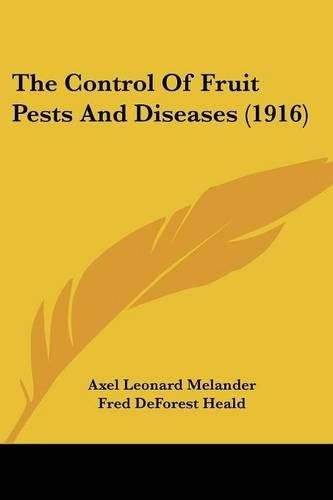Readings Newsletter
Become a Readings Member to make your shopping experience even easier.
Sign in or sign up for free!
You’re not far away from qualifying for FREE standard shipping within Australia
You’ve qualified for FREE standard shipping within Australia
The cart is loading…






Purchase of this book includes free trial access to www.million-books.com where you can read more than a million books for free. This is an OCR edition with typos. Excerpt from book: caused by the feeding punctures of leaf hoppers. Such leaves are apt to show the slender whitish insects living on the under sides. The winged adults fly out when disturbed. Leaf hoppers are dangerous by draining the strength of the trees and stunting the fruit. Nicotine spray is recommended. Apple Tingis (Corythuca annulata) The leaves of apple trees in western Washington sometimes develop brownish spots due to the feeding punctures of the Tingis. The insects themselves are flat, grayish and tiny, the adults having lacy vings. Nicotine spray is the suggested control. Orchard Mite or Brown Mite (Bryobia pratensis) This microscopic creature is not an insect, but is a relative of the spider group as is indicated by the common name of red spider. The red spiders of the genus Tetranychus are not so common as orchard pests. They pass the winter in the ground in a hibernating condition. The orchard mites exist in the egg stage during winter, the microscopic salmon-red eggs sometimes forming clusters on the bark of the branches they infest. There are several broods of the mites during the summer, reproducing by thinner-shelled summer eggs 1'aid on leaves and bark. Orchard mites feed on the leaf tissue causing the foliage to become brownish and dry, and to drop early. Treatment.?The winter eggs are extremely resistant, hatching even when coated with lime-sulphur or oil emulsion. However, orchards sprayed with lime-sulphur are not likely to develop much mite injury because of the injurious effects of this spray on the young hatching mites. Nicotine sprays are perhaps the best treatment; the addition of nicotine to the dormant lime-sulphur spray being an ideal combination. Plain cold water will often suffice to combat the mites after they have hatched and may be applied with …
$9.00 standard shipping within Australia
FREE standard shipping within Australia for orders over $100.00
Express & International shipping calculated at checkout
Purchase of this book includes free trial access to www.million-books.com where you can read more than a million books for free. This is an OCR edition with typos. Excerpt from book: caused by the feeding punctures of leaf hoppers. Such leaves are apt to show the slender whitish insects living on the under sides. The winged adults fly out when disturbed. Leaf hoppers are dangerous by draining the strength of the trees and stunting the fruit. Nicotine spray is recommended. Apple Tingis (Corythuca annulata) The leaves of apple trees in western Washington sometimes develop brownish spots due to the feeding punctures of the Tingis. The insects themselves are flat, grayish and tiny, the adults having lacy vings. Nicotine spray is the suggested control. Orchard Mite or Brown Mite (Bryobia pratensis) This microscopic creature is not an insect, but is a relative of the spider group as is indicated by the common name of red spider. The red spiders of the genus Tetranychus are not so common as orchard pests. They pass the winter in the ground in a hibernating condition. The orchard mites exist in the egg stage during winter, the microscopic salmon-red eggs sometimes forming clusters on the bark of the branches they infest. There are several broods of the mites during the summer, reproducing by thinner-shelled summer eggs 1'aid on leaves and bark. Orchard mites feed on the leaf tissue causing the foliage to become brownish and dry, and to drop early. Treatment.?The winter eggs are extremely resistant, hatching even when coated with lime-sulphur or oil emulsion. However, orchards sprayed with lime-sulphur are not likely to develop much mite injury because of the injurious effects of this spray on the young hatching mites. Nicotine sprays are perhaps the best treatment; the addition of nicotine to the dormant lime-sulphur spray being an ideal combination. Plain cold water will often suffice to combat the mites after they have hatched and may be applied with …